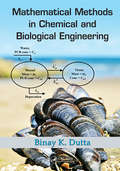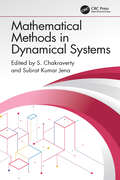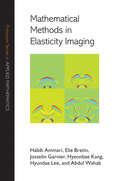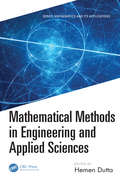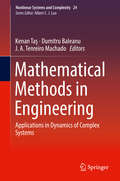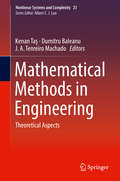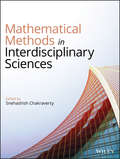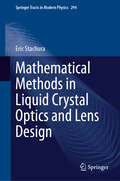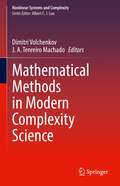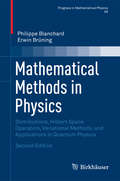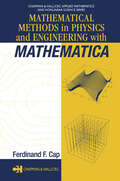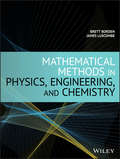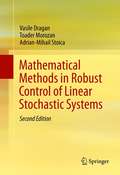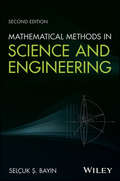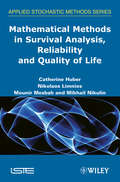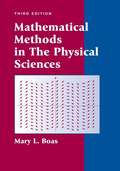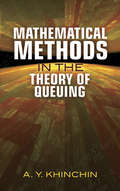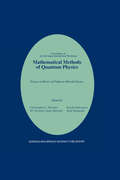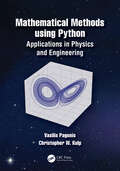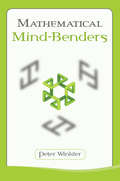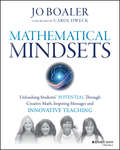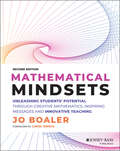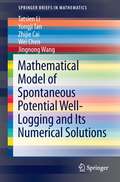- Table View
- List View
Mathematical Methods in Chemical and Biological Engineering
by Binay Kanti DuttaMathematical Methods in Chemical and Biological Engineering describes basic to moderately advanced mathematical techniques useful for shaping the model-based analysis of chemical and biological engineering systems. Covering an ideal balance of basic mathematical principles and applications to physico-chemical problems, this book presents examples drawn from recent scientific and technical literature on chemical engineering, biological and biomedical engineering, food processing, and a variety of diffusional problems to demonstrate the real-world value of the mathematical methods. Emphasis is placed on the background and physical understanding of the problems to prepare students for future challenging and innovative applications.
Mathematical Methods in Dynamical Systems
by S. Chakraverty Subrat Kumar JenaThe art of applying mathematics to real-world dynamical problems such as structural dynamics, fluid dynamics, wave dynamics, robot dynamics, etc. can be extremely challenging. Various aspects of mathematical modelling that may include deterministic or uncertain (fuzzy, interval, or stochastic) scenarios, along with integer or fractional order, are vital to understanding these dynamical systems. Mathematical Methods in Dynamical Systems offers problem-solving techniques and includes different analytical, semi-analytical, numerical, and machine intelligence methods for finding exact and/or approximate solutions of governing equations arising in dynamical systems. It provides a singular source of computationally efficient methods to investigate these systems and includes coverage of various industrial applications in a simple yet comprehensive way.
Mathematical Methods in Elasticity Imaging
by Elie Bretin Abdul Wahab Hyeonbae Kang Habib Ammari Hyundae Lee Josselin GarnierThis book is the first to comprehensively explore elasticity imaging and examines recent, important developments in asymptotic imaging, modeling, and analysis of deterministic and stochastic elastic wave propagation phenomena. It derives the best possible functional images for small inclusions and cracks within the context of stability and resolution, and introduces a topological derivative-based imaging framework for detecting elastic inclusions in the time-harmonic regime. For imaging extended elastic inclusions, accurate optimal control methodologies are designed and the effects of uncertainties of the geometric or physical parameters on stability and resolution properties are evaluated. In particular, the book shows how localized damage to a mechanical structure affects its dynamic characteristics, and how measured eigenparameters are linked to elastic inclusion or crack location, orientation, and size. Demonstrating a novel method for identifying, locating, and estimating inclusions and cracks in elastic structures, the book opens possibilities for a mathematical and numerical framework for elasticity imaging of nanoparticles and cellular structures.
Mathematical Methods in Engineering and Applied Sciences (Mathematics and its Applications)
by Hemen DuttaThis book covers tools and techniques used for developing mathematical methods and modelling related to real-life situations. It brings forward significant aspects of mathematical research by using different mathematical methods such as analytical, computational, and numerical with relevance or applications in engineering and applied sciences. Presents theory, methods, and applications in a balanced manner Includes the basic developments with full details Contains the most recent advances and offers enough references for further study Written in a self-contained style and provides proof of necessary results Offers research problems to help early career researchers prepare research proposals Mathematical Methods in Engineering and Applied Sciences makes available for the audience, several relevant topics in one place necessary for crucial understanding of research problems of an applied nature. This should attract the attention of general readers, mathematicians, and engineers interested in new tools and techniques required for developing more accurate mathematical methods and modelling corresponding to real-life situations.
Mathematical Methods in Engineering: Applications in Dynamics of Complex Systems (Nonlinear Systems and Complexity #24)
by Dumitru Baleanu Kenan Taş J. A. MachadoThis book presents recent developments in nonlinear dynamics with an emphasis on complex systems. The volume illustrates new methods to characterize the solutions of nonlinear dynamics associated with complex systems. This book contains the following topics: new solutions of the functional equations, optimization algorithm for traveling salesman problem, fractals, control, fractional calculus models, fractional discretization, local fractional partial differential equations and their applications, and solutions of fractional kinetic equations.
Mathematical Methods in Engineering: Theoretical Aspects (Nonlinear Systems and Complexity #23)
by Dumitru Baleanu Kenan Taş J. A. MachadoThis book collects chapters dealing with some of the theoretical aspects needed to properly discuss the dynamics of complex engineering systems. The book illustrates advanced theoretical development and new techniques designed to better solve problems within the nonlinear dynamical systems. Topics covered in this volume include advances on fixed point results on partial metric spaces, localization of the spectral expansions associated with the partial differential operators, irregularity in graphs and inverse problems, Hyers-Ulam and Hyers-Ulam-Rassias stability for integro-differential equations, fixed point results for mixed multivalued mappings of Feng-Liu type on Mb-metric spaces, and the limit q-Bernstein operators, analytical investigation on the fractional diffusion absorption equation.
Mathematical Methods in Interdisciplinary Sciences
by Snehashish ChakravertyBrings mathematics to bear on your real-world, scientific problems Mathematical Methods in Interdisciplinary Sciences provides a practical and usable framework for bringing a mathematical approach to modelling real-life scientific and technological problems. The collection of chapters Dr. Snehashish Chakraverty has provided describe in detail how to bring mathematics, statistics, and computational methods to the fore to solve even the most stubborn problems involving the intersection of multiple fields of study. Graduate students, postgraduate students, researchers, and professors will all benefit significantly from the author's clear approach to applied mathematics. The book covers a wide range of interdisciplinary topics in which mathematics can be brought to bear on challenging problems requiring creative solutions. Subjects include: Structural static and vibration problems Heat conduction and diffusion problems Fluid dynamics problems The book also covers topics as diverse as soft computing and machine intelligence. It concludes with examinations of various fields of application, like infectious diseases, autonomous car and monotone inclusion problems.
Mathematical Methods in Liquid Crystal Optics and Lens Design (Springer Tracts in Modern Physics #294)
by Eric StachuraFreeform lens design has numerous applications in imaging, aerospace, and biomedicine. Due to recent advancements in precision cutting and grinding, the manufacturing of freeform optical lenses with very high precision is now possible. However, there is still a significant lack of mathematical literature on the subject, and essentially none related to liquid crystals. Liquid crystals are appealing for use in imaging due to their flexibility and unique electro-optical properties. This book fills a gap in mathematical literature and attracts focus to liquid crystals for freeform lens design. It provides a rigorous mathematical perspective on liquid crystal optics, focusing on ray tracing in the geometric optics regime. A mathematical foundation is set to study lens design and ray tracing problems in liquid crystals. Additionally, it addresses absolute instruments, which are devices that image without any optical aberrations. These instruments cannot be designed through transformation optics, and until recently, only a handful of examples were known. Mathematically, this is a largely untapped area of research, yet the applications are profound. Finally, the book describes several open directions, revealing the richness of the intersection of liquid crystal optics and mathematical analysis. The content of this book will prove invaluable for researchers of mathematical optics as well as those interested in liquid crystal theory, in addition to those mathematics graduate students aiming to understand the physical basis of light propagation in liquid crystals
Mathematical Methods in Modern Complexity Science (Nonlinear Systems and Complexity #33)
by Dimitri Volchenkov J. A. Tenreiro MachadoThis book presents recent developments in nonlinear and complex systems. It provides recent theoretic developments and new techniques based on a nonlinear dynamical systems approach that can be used to model and understand complex behavior in nonlinear dynamical systems. It covers information theory, relativistic chaotic dynamics, data analysis, relativistic chaotic dynamics, solvability issues in integro-differential equations, and inverse problems for parabolic differential equations, synchronization and chaotic transient. Presents new concepts for understanding and modeling complex systems
Mathematical Methods in Physics
by Philippe Blanchard Erwin BrüningThe second edition of this textbook presents the basic mathematical knowledge and skills that are needed for courses on modern theoretical physics, such as those on quantum mechanics, classical and quantum field theory, and related areas. The authors stress that learning mathematical physics is not a passive process and include numerous detailed proofs, examples, and over 200 exercises, as well as hints linking mathematical concepts and results to the relevant physical concepts and theories. All of the material from the first edition has been updated, and five new chapters have been added on such topics as distributions, Hilbert space operators, and variational methods. The text is divided into three parts: - Part I: A brief introduction to (Schwartz) distribution theory. Elements from the theories of ultra distributions and (Fourier) hyperfunctions are given in addition to some deeper results for Schwartz distributions, thus providing a rather comprehensive introduction to the theory of generalized functions. Basic properties and methods for distributions are developed with applications to constant coefficient ODEs and PDEs. The relation between distributions and holomorphic functions is considered, as well as basic properties of Sobolev spaces. - Part II: Fundamental facts about Hilbert spaces. The basic theory of linear (bounded and unbounded) operators in Hilbert spaces and special classes of linear operators - compact, Hilbert-Schmidt, trace class, and Schrödinger operators, as needed in quantum physics and quantum information theory - are explored. This section also contains a detailed spectral analysis of all major classes of linear operators, including completeness of generalized eigenfunctions, as well as of (completely) positive mappings, in particular quantum operations. - Part III: Direct methods of the calculus of variations and their applications to boundary- and eigenvalue-problems for linear and nonlinear partial differential operators. The authors conclude with a discussion of the Hohenberg-Kohn variational principle. The appendices contain proofs of more general and deeper results, including completions, basic facts about metrizable Hausdorff locally convex topological vector spaces, Baire's fundamental results and their main consequences, and bilinear functionals. Mathematical Methods in Physics is aimed at a broad community of graduate students in mathematics, mathematical physics, quantum information theory, physics and engineering, as well as researchers in these disciplines. Expanded content and relevant updates will make this new edition a valuable resource for those working in these disciplines.
Mathematical Methods in Physics and Engineering with Mathematica (Chapman & Hall/CRC Applied Mathematics & Nonlinear Science)
by Ferdinand F. CapMore than ever before, complicated mathematical procedures are integral to the success and advancement of technology, engineering, and even industrial production. Knowledge of and experience with these procedures is therefore vital to present and future scientists, engineers and technologists.Mathematical Methods in Physics and Engineering
Mathematical Methods in Physics, Engineering, and Chemistry
by James Luscombe Brett BordenA concise and up-to-date introduction to mathematical methods for students in the physical sciences Mathematical Methods in Physics, Engineering and Chemistry offers an introduction to the most important methods of theoretical physics. Written by two physics professors with years of experience, the text puts the focus on the essential math topics that the majority of physical science students require in the course of their studies. This concise text also contains worked examples that clearly illustrate the mathematical concepts presented and shows how they apply to physical problems. This targeted text covers a range of topics including linear algebra, partial differential equations, power series, Sturm-Liouville theory, Fourier series, special functions, complex analysis, the Green’s function method, integral equations, and tensor analysis. This important text: Provides a streamlined approach to the subject by putting the focus on the mathematical topics that physical science students really need Offers a text that is different from the often-found definition-theorem-proof scheme Includes more than 150 worked examples that help with an understanding of the problems presented Presents a guide with more than 200 exercises with different degrees of difficulty Written for advanced undergraduate and graduate students of physics, materials science, and engineering, Mathematical Methods in Physics, Engineering and Chemistry includes the essential methods of theoretical physics. The text is streamlined to provide only the most important mathematical concepts that apply to physical problems.
Mathematical Methods in Physics: Partial Differential Equations, Fourier Series, and Special Functions
by Victor Henner Tatyana Belozerova Kyle ForinashThis book is a text on partial differential equations (PDEs) of mathematical physics and boundary value problems, trigonometric Fourier series, and special functions. This is the core content of many courses in the fields of engineering, physics, mathematics, and applied mathematics. The accompanying software provides a laboratory environment that
Mathematical Methods in Robust Control of Linear Stochastic Systems
by Vasile Dragan Toader Morozan Adrian-Mihail StoicaThis second edition of Mathematical Methods in the Robust Control of Linear Stochastic Systems includes a large number of recent results in the control of linear stochastic systems. More specifically, the new results presented are: - A unified and abstract framework for Riccati type equations arising in the stochastic control - Stability and control problems for systems perturbed by homogeneous Markov processes with infinite number of states - Mixed H2 / H∞ control problem and numerical procedures - Linear differential equations with positive evolution on ordered Banach spaces with applications for stochastic systems including both multiplicative white noise and Markovian jumps represented by a Markov chain with countable infinite set of states - Kalman filtering for stochastic systems subject both to state dependent noise and Markovian jumps - H∞ reduced order filters for stochastic systems The book will appeal to graduate students, researchers in advanced control engineering, finance, mathematical systems theory, applied probability and stochastic processes, and numerical analysis. From Reviews of the First Edition: This book is concerned with robust control of stochastic systems. One of the main features is its coverage of jump Markovian systems. . . . Overall, this book presents results taking into consideration both white noise and Markov chain perturbations. It is clearly written and should be useful for people working in applied mathematics and in control and systems theory. The references cited provide further reading sources. (George Yin, Mathematical Reviews, Issue 2007 m) This book considers linear time varying stochastic systems, subjected to white noise disturbances and system parameter Markovian jumping, in the context of optimal control . . . robust stabilization, and disturbance attenuation. . . . The material presented in the book is organized in seven chapters. . . . The book is very well written and organized. . . . is a valuable reference for all researchers and graduate students in applied mathematics and control engineering interested in linear stochastic time varying control systems with Markovian parameter jumping and white noise disturbances. (Zoran Gajic, SIAM Review, Vol. 49 (3), 2007)
Mathematical Methods in Science and Engineering
by Selçuk S. BayinA Practical, Interdisciplinary Guide to Advanced Mathematical Methods for Scientists and Engineers Mathematical Methods in Science and Engineering, Second Edition, provides students and scientists with a detailed mathematical reference for advanced analysis and computational methodologies. Making complex tools accessible, this invaluable resource is designed for both the classroom and the practitioners; the modular format allows flexibility of coverage, while the text itself is formatted to provide essential information without detailed study. Highly practical discussion focuses on the “how-to” aspect of each topic presented, yet provides enough theory to reinforce central processes and mechanisms. Recent growing interest in interdisciplinary studies has brought scientists together from physics, chemistry, biology, economy, and finance to expand advanced mathematical methods beyond theoretical physics. This book is written with this multi-disciplinary group in mind, emphasizing practical solutions for diverse applications and the development of a new interdisciplinary science. Revised and expanded for increased utility, this new Second Edition: Includes over 60 new sections and subsections more useful to a multidisciplinary audience Contains new examples, new figures, new problems, and more fluid arguments Presents a detailed discussion on the most frequently encountered special functions in science and engineering Provides a systematic treatment of special functions in terms of the Sturm-Liouville theory Approaches second-order differential equations of physics and engineering from the factorization perspective Includes extensive discussion of coordinate transformations and tensors, complex analysis, fractional calculus, integral transforms, Green's functions, path integrals, and more Extensively reworked to provide increased utility to a broader audience, this book provides a self-contained three-semester course for curriculum, self-study, or reference. As more scientific disciplines begin to lean more heavily on advanced mathematical analysis, this resource will prove to be an invaluable addition to any bookshelf.
Mathematical Methods in Survival Analysis, Reliability and Quality of Life
by Nikolaos Limnios Mounir Mesbah Mikhail Nikulin Catherine HuberReliability and survival analysis are important applications of stochastic mathematics (probability, statistics and stochastic processes) that are usually covered separately in spite of the similarity of the involved mathematical theory. This title aims to redress this situation: it includes 21 chapters divided into four parts: Survival analysis, Reliability, Quality of life, and Related topics. Many of these chapters were presented at the European Seminar on Mathematical Methods for Survival Analysis, Reliability and Quality of Life in 2006.
Mathematical Methods in the Physical Sciences (Third Edition)
by Mary L. BoasNow in its third edition, Mathematical Concepts in the Physical Sciences, 3rd Edition provides a comprehensive introduction to the areas of mathematical physics. It combines all the essential math concepts into one compact, clearly written reference. This book is intended for students who have had a two-semester or three-semester introductory calculus course. Its purpose is to help students develop, in a short time, a basic competence in each of the many areas of mathematics needed in advanced courses in physics, chemistry, and engineering. Students are given sufficient depth to gain a solid foundation (this is not a recipe book). At the same time, they are not overwhelmed with detailed proofs that are more appropriate for students of mathematics. The emphasis is on mathematical methods rather than applications, but students are given some idea of how the methods will be used along with some simple applications.
Mathematical Methods in the Theory of Queuing (Dover Books on Mathematics)
by A. Y. Khinchin D. M. Andrews M. H. QuenouilleWritten by a prominent Russian mathematician, this concise monograph examines aspects of queuing theory as an application of probability. The three-part treatment begins with a study of the stream of incoming demands (or "calls," in the author's terminology). Subsequent sections explore systems with losses and systems allowing delay. Prerequisites include a familiarity with the theory of probability and mathematical analysis. A. Y. Khinchin made significant contributions to probability theory, statistical physics, and several other fields. His elegant, groundbreaking work will prove of substantial interest to advanced undergraduates, graduate students, and professionals in the fields of statistics, probability, and operations research.
Mathematical Methods of Many-Body Quantum Field Theory (Chapman & Hall/CRC Research Notes in Mathematics Series)
by Detlef LehmannMathematical Methods of Many-Body Quantum Field Theory offers a comprehensive, mathematically rigorous treatment of many-body physics. It develops the mathematical tools for describing quantum many-body systems and applies them to the many-electron system. These tools include the formalism of second quantization, field theoretical perturbation theo
Mathematical Methods of Quantum Physics: Essays in Honor of Professor Hiroshi Ezawa
by Christopher C. BernidoArticles are presented, covering a wide range of topics in the mathematical methods of quantum physics. These include infinite dimensional analysis based on white noise, operator algebra methods, Feynman path integrals, quantum mechanics on non-simply connected spaces, recent results in supersymmetric theories, stochastic and quantum dynamics, Yang-Baxter systems, statistical physics, thermo field dynamics, and quantum field theory. The essays are based on lectures contributed for the Second Jagna International Workshop held in honour of Prof. Hiroshi Ezawa, a distinguished physicist, educator, and former president of the Physical Society of Japan.
Mathematical Methods using Python: Applications in Physics and Engineering
by Vasilis Pagonis Christopher Wayne KulpThis advanced undergraduate textbook presents a new approach to teaching mathematical methods for scientists and engineers. It provides a practical, pedagogical introduction to utilizing Python in Mathematical and Computational Methods courses. Both analytical and computational examples are integrated from its start. Each chapter concludes with a set of problems designed to help students hone their skills in mathematical techniques, computer programming, and numerical analysis. The book places less emphasis on mathematical proofs, and more emphasis on how to use computers for both symbolic and numerical calculations. It contains 182 extensively documented coding examples, based on topics that students will encounter in their advanced courses in Mechanics, Electronics, Optics, Electromagnetism, Quantum Mechanics etc.An introductory chapter gives students a crash course in Python programming and the most often used libraries (SymPy, NumPy, SciPy, Matplotlib). This is followed by chapters dedicated to differentiation, integration, vectors and multiple integration techniques. The next group of chapters covers complex numbers, matrices, vector analysis and vector spaces. Extensive chapters cover ordinary and partial differential equations, followed by chapters on nonlinear systems and on the analysis of experimental data using linear and nonlinear regression techniques, Fourier transforms, binomial and Gaussian distributions. The book is accompanied by a dedicated GitHub website, which contains all codes from the book in the form of ready to run Jupyter notebooks. A detailed solutions manual is also available for instructors using the textbook in their courses.Key Features:· A unique teaching approach which merges mathematical methods and the Python programming skills which physicists and engineering students need in their courses.· Uses examples and models from physical and engineering systems, to motivate the mathematics being taught.· Students learn to solve scientific problems in three different ways: traditional pen-and-paper methods, using scientific numerical techniques with NumPy and SciPy, and using Symbolic Python (SymPy).Vasilis Pagonis is Professor of Physics Emeritus at McDaniel College, Maryland, USA. His research area is applications of thermally and optically stimulated luminescence. He taught courses in mathematical physics, classical and quantum mechanics, analog and digital electronics and numerous general science courses. Dr. Pagonis’ resume lists more than 200 peer-reviewed publications in international journals. He is currently associate editor of the journal Radiation Measurements. He is co-author with Christopher Kulp of the undergraduate textbook “Classical Mechanics: a computational approach, with examples in Python and Mathematica” (CRC Press, 2020). He has also co-authored four graduate-level textbooks in the field of luminescence dosimetry, and most recently published the book “Luminescence Signal analysis using Python” (Springer, 2022).Christopher Kulp is the John P. Graham Teaching Professor of Physics at Lycoming College. He has been teaching undergraduate physics at all levels for 20 years. Dr. Kulp’s research focuses on modelling complex systems, time series analysis, and machine learning. He has published 30 peer-reviewed papers in international journals, many of which include student co-authors. He is also co-author of the undergraduate textbook “Classical Mechanics: a computational approach, with examples in Python and Mathematica” (CRC Press, 2020).
Mathematical Mind-Benders (AK Peters/CRC Recreational Mathematics Series)
by Peter WinklerPeter Winkler is at it again. Following the enthusiastic reaction to Mathematical Puzzles: A Connoisseur's Collection, Peter has compiled a new collection of elegant mathematical puzzles to challenge and entertain the reader. The original puzzle connoisseur shares these puzzles, old and new, so that you can add them to your own anthology. This book
Mathematical Mindsets: Unleashing Students' Potential through Creative Math, Inspiring Messages and Innovative Teaching
by Jo BoalerBanish math anxiety and give students of all ages a clear roadmap to success Mathematical Mindsets provides practical strategies and activities to help teachers and parents show all children, even those who are convinced that they are bad at math, that they can enjoy and succeed in math. Jo Boaler--Stanford researcher, professor of math education, and expert on math learning--has studied why students don't like math and often fail in math classes. She's followed thousands of students through middle and high schools to study how they learn and to find the most effective ways to unleash the math potential in all students. There is a clear gap between what research has shown to work in teaching math and what happens in schools and at home. This book bridges that gap by turning research findings into practical activities and advice. Boaler translates Carol Dweck's concept of 'mindset' into math teaching and parenting strategies, showing how students can go from self-doubt to strong self-confidence, which is so important to math learning. Boaler reveals the steps that must be taken by schools and parents to improve math education for all. Mathematical Mindsets: Explains how the brain processes mathematics learning Reveals how to turn mistakes and struggles into valuable learning experiences Provides examples of rich mathematical activities to replace rote learning Explains ways to give students a positive math mindset Gives examples of how assessment and grading policies need to change to support real understanding Scores of students hate and fear math, so they end up leaving school without an understanding of basic mathematical concepts. Their evasion and departure hinders math-related pathways and STEM career opportunities. Research has shown very clear methods to change this phenomena, but the information has been confined to research journals--until now. Mathematical Mindsets provides a proven, practical roadmap to mathematics success for any student at any age.
Mathematical Mindsets: Unleashing Students' Potential through Creative Mathematics, Inspiring Messages and Innovative Teaching
by Jo BoalerReverse mathematics trauma and find a universal blueprint for math success In Mathematical Mindsets: Unleashing Students' Potential through Creative Math, Inspiring Messages and Innovative Teaching mathematics education expert and best-selling author Jo Boaler delivers a blueprint to banishing math anxiety and laying a foundation for mathematics success that anyone can build on. Perfect for students who have been convinced they are naturally "bad at math," the author offers a demonstration of how to turn self-doubt into self-confidence by relying on the "mindset" framework. Mathematical Mindsets is based on thousands of hours of in-depth study and research into the most effective—and ineffective—ways to teach math to young people. This new edition also includes: Brand-new research from the last five years that sheds brighter light on how to turn a fear of math into an enthusiastic desire to learn Developed ideas about ways to bring about equitable grouping in classrooms New initiatives to bring 21st century mathematics to K-12 classrooms Mathematical Mindsets is ideal for K-12 math educators. It also belongs on the bookshelves of the parents interested in helping their K-12 children with their math education, as well as school administrators and educators-in-training.
Mathematical Model of Spontaneous Potential Well-Logging and Its Numerical Solutions
by Wei Chen Tatsien Li Yongji Tan Zhijie Cai Jingnong WangSpontaneous potential (SP) well-logging is one of the most common and useful well-logging techniques in petroleum exploitation. This monograph is the first of its kind on the mathematical model of spontaneous potential well-logging and its numerical solutions. The mathematical model established in this book shows the necessity of introducing Sobolev spaces with fractional power, which seriously increases the difficulty of proving the well-posedness and proposing numerical solution schemes. In this book, in the axisymmetric situation the well-posedness of the corresponding mathematical model is proved and three efficient schemes of numerical solution are proposed, supported by a number of numerical examples to meet practical computation needs.
